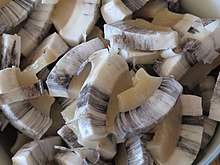Batatokuko
Kamoteng Keyk
lunes, 27 de abril de 2020
"Nipponic" Identity
Many people have confusion about my identity. I could say that I am a multilingual "Nipponic" living in the Anglosphere. I deny neither my "Filipinoness" nor my "Hispanicity."
sábado, 25 de abril de 2020
Western Native American cuisine
In the Pacific Northwest, traditional diets include salmon and other fish, seafood, mushrooms, berries, and meats such as deer, duck, and rabbit. In contrast to the Easterners, the Northwestern peoples are traditionally hunter-gatherers, primarily. The generally mild climate led to the development of an economy based on year-round abundant food supplies, rather than having to rely upon seasonal agriculture. In what is now California, acorns can be ground into a flour that has at times served as the principal foodstuff for about 75 percent of the population,[24] and dried meats can be prepared during the dry season.[25]
https://en.m.wikipedia.org/wiki/Indigenous_cuisine_of_the_Americas
https://en.m.wikipedia.org/wiki/Indigenous_cuisine_of_the_Americas
Tiswin
Tiswin is an alcoholic beverage brewed from corn. Tiswin is also the sacred saguaro wine of the Tohono O'odham, a group of aboriginal Americans who reside primarily in the Sonoran Desert of the southeastern Arizona and northwest Mexico.
The saguaro, the largest cactus in the world, is in many respects the sacred tree of the Tohono O'odham, who reside in the Sonoran Desert of southeastern Arizona and northwest Mexico. From the fruit of the saguaro they make a sacred fermentation called tiswin or sometimes nawai.
https://en.m.wikipedia.org/wiki/Tiswin
https://en.m.wikipedia.org/wiki/Tiswin
Guarani Phonology
Guarani syllables consist of a consonant plus a vowel or a vowel alone; syllables ending in a consonant or two or more consonants together do not occur. This is represented as (C)V(V).
- Vowels: /a/, /e/, /i/, /o/, /u/ correspond more or less to the Spanish and IPA equivalents, although sometimes the allophones [ɛ], [ɔ] are used more frequently; the grapheme ⟨y⟩ represents the vowel /ɨ/ (as in Latgalian).
| Front | Central | Back | |
|---|---|---|---|
| Close | /i/, /ĩ/ | /ɨ/, /ɨ̃/ | /u/, /ũ/ |
| Mid | /e/, /ẽ/ | /o/, /õ/ | |
| Open | /a/, /ã/ |
IPA value is shown. The orthography is shown in angle brackets below, if different.
| Labial | Alveolar | Alveolo-palatal | Velar | Lab. velar | Glottal | ||
|---|---|---|---|---|---|---|---|
| Stop | Voiceless | p | t | k | kʷ ⟨ku⟩ | ʔ ⟨'⟩ | |
| Voiced | ᵐb~m ⟨mb~m⟩ | ⁿd~n ⟨nd~n⟩ | ᵈj~ɲ ⟨j~ñ⟩ | ᵑɡ~ŋ ⟨ng⟩ | ᵑɡʷ~ŋʷ ⟨ngu⟩ | ||
| Fricative | s | ɕ ⟨ch⟩ | x~h ⟨h⟩ | ||||
| Approximant | ʋ ⟨v⟩ | ɰ ~ ɰ̃ ⟨g⟩ ~ ⟨g̃⟩ | w ~ w̃ ⟨gu⟩ ~ ⟨g̃u⟩ | ||||
| Flap | ɾ ⟨r⟩ | ||||||
The voiced consonants have oral allophones (left) before oral vowels, and nasal allophones (right) before nasal vowels. The oral allophones of the voiced stops are prenasalized.
There is also a sequence /ⁿt/ (written ⟨nt⟩). A trill /r/ (written ⟨rr⟩), and the consonants /l/, /f/, and /j/ (written ⟨ll⟩) are not native to Guarani, but come from Spanish.
Oral [ᵈj] is often pronounced [dʒ], [ɟ], [ʒ], [j], depending on the dialect, but the nasal allophone is always [ɲ].
The dorsal fricative is in free variation between [x] and [h].
⟨g⟩, ⟨gu⟩ are approximants, not fricatives, but are sometimes transcribed [ɣ], [ɣʷ], as is conventional for Spanish. ⟨gu⟩ is also transcribed [ɰʷ], which is essentially identical to [w].
All syllables are open, viz. CV or V, ending in a vowel.
Glottal stop
The glottal stop is only written between vowels, but occurs phonetically before vowel-initial words. Because of this, Ayala (2000:19) shows that some words have several glottal stops near each other, which consequently undergo a number of different dissimilationtechniques. For example, "I drink water" 'a'u'y is pronounced hau'y. This suggests that irregularity in verb forms derives from regular sound change processes in the history of Guarani. There also seems to be some degree of variation between how much the glottal stop is dropped (for example aru'uka > aruuka > aruka for "I bring"). It is possible that word-internal glottal stops may have been retained from fossilized compounds where the second component was a vowel-initial (and therefore glottal stop–initial) root.[20]:19
Nasal harmony
Guarani displays an unusual degree of nasal harmony. A nasal syllable consists of a nasal vowel, and if the consonant is voiced, it takes its nasal allophone. If a stressed syllable is nasal, the nasality spreads in both directions until it bumps up against a stressed syllable that is oral. This includes affixes, postpositions, and compounding. Voiceless consonants do not have nasal allophones, but they do not interrupt the spread of nasality.
For example,
- /ⁿdo+ɾoi+ⁿduˈpã+i/ → [nõɾ̃õĩnũˈpãĩ]
- /ro+ᵐbo+poˈrã/ → [ɾ̃õmõpõˈɾ̃ã]
However, a second stressed syllable, with an oral vowel, will not become nasalized:
- /iᵈjaˈkãɾaˈku/ → [ʔĩɲãˈkãɾ̃ãˈku]
- /aˈkãɾaˈwe/ → [ʔãˈkãɾ̃ãˈwe][21]
That is, for a word with a single stressed vowel, all voiced segments will be either oral or nasal, while voiceless consonants are unaffected, as in oral /ᵐbotɨ/ vs nasal /mõtɨ̃/.
https://en.m.wikipedia.org/wiki/Guarani_language
https://en.m.wikipedia.org/wiki/Guarani_language
Muktuk
Muktuk is most often made from the skin and blubber of the bowhead whale, although the beluga and the narwhal are also used. Usually eaten raw, today it is occasionally finely diced, breaded, deep fried, and then served with soy sauce. Despite it being usually eaten raw it could also be eaten frozen or cooked.[2] It is also sometimes pickled.[3] When chewed raw, the blubber becomes oily, with a nutty taste; if not diced, or at least serrated, the skin is quite rubbery.
Italio kaj Francio inter Japanoj
Multaj japanoj opinias, ke inter eŭropaj landoj, eble Italio kaj Francio plej allogas japanojn.
Suscribirse a:
Comentarios (Atom)
-
<< The Shastan (or Sastean ) family consisted of four languages, spoken in present-day northern California and southern Orego...










